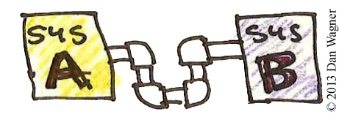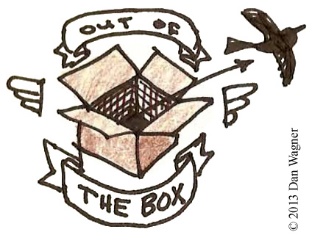What is Your Modeling Mindset?
Pictures are an important part of BA work. Whether you call it modeling or diagraming or mapping or drawing, the techniques BAs use to turn processes, relationships, ideas and tasks into pictures, remains a valuable technique for nearly every phase of project work.
From spontaneously sketching ideas on a whiteboard to solve a problem during a meeting, to high-level conceptual models to define scope, to full scale data diagrams to look at detailed data requirements; our work demands a visual approach. Words have their place of importance, but pictures bring value that text and dialogue simply can’t.
“Of all of our inventions for mass communication, pictures still speak the most universally understood language.” –Walt Disney
And yet, while the importance of pictures seems obvious to many, some still do not use pictures and models as part of a regular approach to requirements. They discount the value of visuals or lack the skills and confidence to produce effective visuals.
Even BAs that passionately advocate the use of visuals disagree about why they are important and how they should be used.
So, what’s your modeling mindset?
Where are you on the visual continuum?
Are you using all text or all pictures or are you somewhere in between?
Mindset #1: I don’t need a picture.
Many organizations manage project deliverables and documentation with templates. Traditionally, many templates like the Business Requirements Document focus solely on text as required elements of the document. The text might be organized well and easy to read, but it’s difficult to understand context.
Your busy stakeholders need a way to understand, at a glance, what part of their world the solution and/or your document describes or impacts. What’s in it for me? (WIIFM)—that’s what the stakeholders want to know when they browse your project documents. WIIFM is so much easier to locate in a picture than by skimming dense text. Pictures also make it easier to see connections and relationships between elements.
Even if your template does not include a space for visuals, make space! Just because your template does not require a model or a diagram, doesn’t mean that you can’t add one.
Mindset #2: Models are a deliverable.
Some organizations approach models and diagrams with a “because I’m supposed to” mindset. Their standard BA task lists might include a process model, a user interaction diagram, and a data flow diagram. Instead of thinking about how to use visual artifacts to bring value to the project, the visuals just become an item to check off the “to do” list. If your organization’s culture on visuals sounds like this; challenge yourself to draw outside that box and bring visuals back to life for the purpose of dialog vs. a checklist.
Mindset #3: Models validate requirements.
Pictures, diagrams and models help BAs validate requirements. Strong BAs create multiple models and diagrams to help themselves understand and analyze requirements, and each stakeholder validate requirements at their appropriate level of detail. The models help everyone visualize products and processes. Requirement gaps and errors become more obvious than they would be in text only documents.
Mindset #4: Pictures start a conversation and take the conversation deeper.
Dialogue is the primary benefit of visual artifacts! Pictures get conversations started and pull conversations to a deeper, more meaningful place. Using this mindset, BAs can combine visuals with great facilitation techniques to engage ALL stakeholders and boost collaboration and creativity in areas of project work.
Mindset #5: Diagrams and models are technical and for the developers
When some organizations make the leap to visual communication and they get really serious about their pictures, the notation used, and the details. These are models and diagrams for the technical audience. These can be useful for technical collaboration, but not at the expense of the bigger picture.
Mindset #6: All I need is a picture.
Can a picture replace words? Do you need text documents to supplement user diagrams, or process flows, or product supply chain maps? Pictures and text accompanying one another are magical!
There might be projects where a well-functioning team can create a cycle of collaboration and prototyping (working pictures), diagrams, sketches, and models that do not require text. They may have a unique understanding of context together and are all aligned on the context and connections together. Most teams do not have this level of shared understanding with out a combination of pictures and text.
Wrap Up
In general, I am seeing that organizations don’t do enough modeling. Project teams need visuals to inspire dialogue and get people to look at things in different ways.
“When words become unclear, I shall focus with photographs,” said renowned American photographer, Ansel Adams.
BAs should focus their models and diagrams with their stakeholder’s perspective in mind. Some things to think about when working on your next visual?
- Is the picture defining a concept or details?
- Is the purpose to generate dialog or confirm dialog?
- Should the model have a system perspective or a user perspective or a product perspective?
- Who is contributing to the model, reviewing the model, or approving the model? What’s in it for them?
- How you can use pictures to shine a light on gaps, issues, dependencies, constraints and risks.
Start experimenting. Find new ways to use models and diagrams to engage stakeholders and boost collaboration! If you have a favorite visual tool or technique, please share it by leaving a comment below.
Don’t forget to leave your comments below.





 You need an internal BA (or BA team) to support a package software project. If you rely solely on the vendor BA, you will not successfully identify and bridge functionality gaps. The vendor BA understands the product, but does not fully understand your environment—your systems, processes, culture, politics, pain points, exception processing, integration issues, etc.
You need an internal BA (or BA team) to support a package software project. If you rely solely on the vendor BA, you will not successfully identify and bridge functionality gaps. The vendor BA understands the product, but does not fully understand your environment—your systems, processes, culture, politics, pain points, exception processing, integration issues, etc. A note about configuration
A note about configuration